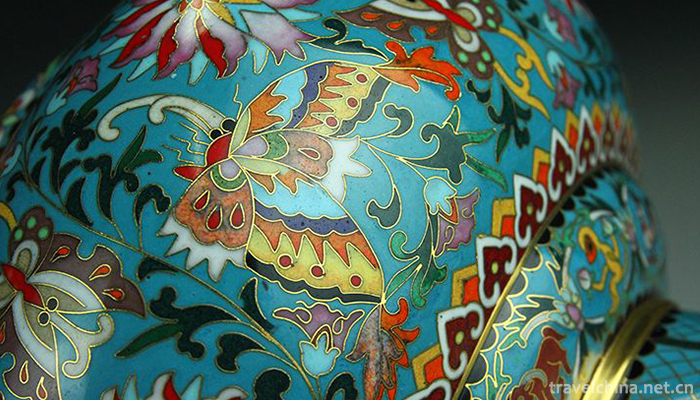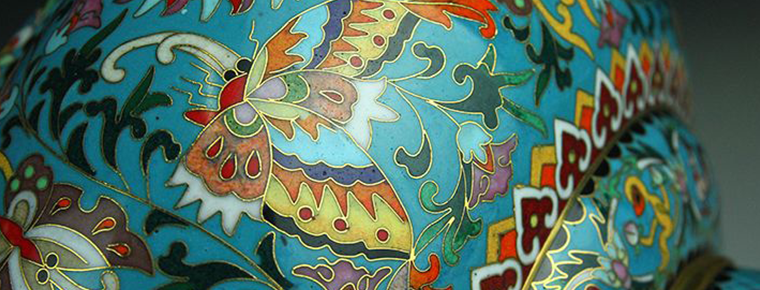Cloisonne Production Techniques
Cloisonne Production Techniques
Cloisonne production skills, Chongwen District, Beijing, local traditional skills, one of the national intangible cultural heritage.
Cloisonne technology is a combination of external enamel technology and native metal enamel technology. During the Ming and Qing dynasties, the Imperial Supervisor and the Establishment Office set up enamel workshops in Beijing specially serving the Royal family. Their skills changed from maturity to brilliance. Since modern times, social unrest, Beijing Cloisonne skills once declined. After 1949, this ancient skill was rapidly restored and developed because of the active protection and support policies adopted by the state.
On May 20, 2006, Cloisonne production technology was approved by the State Council and listed in the first batch of national intangible cultural heritage list, numbered_-43.
historical origin
Cloisonne has a long history of development. However, due to insufficient documentation and the lack of early reliable products as the basis for dating, there is no final conclusion so far. As far as we know, the earliest records of metal enamel products in China can only be found in Gegu Yao Lun written by Cao Zhao in Hongwu 21 years in the early Ming Dynasty. The "big kiln ware" recorded in the book is the "carcass thread enamel" products.
According to the analysis of historical data, around the end of the thirteenth century, "copper tyre enamel" was introduced into China from the Arab region. At the beginning of its introduction, there were many terms such as "big kiln ware" and "hair groom". The earliest existing enamel products in China are the late Yuan Dynasty products collected by the Palace Museum, such as animal ears, tripod oven of Goulian and Elephant Ear oven of tangled branch lotus. It is said that Jingtai was the son of Emperor Xuande of the Ming Dynasty. Xuande attached great importance to copper wares and casting and smelting copper. Jingtai was immersed in her childhood, and had a very detailed knowledge and a deep love for it. However, Xuande had reached the top in the field of casting and had no ability to make further breakthroughs, so she created a new path in the aspect of color to achieve a surprising victory. Finally, there is the creation of "Cloisonne". Because of the painstaking planning of color in advance, after success, they also love it very much. All imperial ornaments need not be made with "cloisonne". There are many kinds of ornaments that can not be counted down. There are all kinds of porcelain that can be made.
Chenghua period inherited the legacy, did not change the legacy, still strive to burn, so Cloisonne objects in Jingtai and Chenghua two keys are most common. Later, through the four dynasties of Hongzhi, Zhengde and Jiajing Longqing, although still burned, they all follow the rules and falsely respond to stories, which are not comparable in quality with Jingtai and Chengdu.
After Wanli, although occasionally burned, it was not as routine as setting up official factories, so it was later produced.
Very few. In the Qianlong period of the Qing Dynasty, it began to burn again, with many kinds and good results. Although it can not be compared with the Jingtai and Chenghua periods, it is no inferior to the products produced after Hongzheng. At this time, the distinct national style of Cloisonne is deeply loved by Westerners. Cloisonne crafts began to be exported as an important export commodity. Under the stimulation of foreign trade, besides government-run enamel workshops, private businesses and stores have been opened one after another to operate cloisonne products, such as Lao Tian Li Baohua Sheng, Jing Yuan Tang Zhiyuan Tang and so on.
With the development of modern times, although Cloisonne Crafts have various styles and different production methods, they still use the customary title of "cloisonne".
Process characteristics
Cloisonne's production technology, which not only uses the traditional bronze and porcelain firing technology, but also absorbs the traditional painting and sculpture techniques, can be regarded as the master of Chinese traditional crafts. The handicraft produced has the artistic characteristics of vigor, dignity, richness and elegance.
Cloisonne technology is a combination of external enamel technology and native metal enamel technology. It integrates history, culture, art and traditional crafts. It is simple and elegant, exquisite and luxurious. It has a unique national artistic style and profound cultural connotation.
Inheritance and protection
Inheritance value
Jingtailan in Beijing has complex skills and various processes. It combines bronze and enamel techniques, inherits traditional painting and metal engraving techniques, and embodies the tradition of learning from each other among traditional Chinese arts and crafts. Cloisonne products are elegant in shape, complicated in pattern, rich in color, and have the characteristics of court art. They give people the artistic feeling of "round and solid, golden and brilliant". They have high artistic value. They have participated in important exhibitions at home and abroad for many times, won honors for China, and are often presented as Chinese gifts to foreign guests.
Inheriting characters
Qian Meihua, female, Han nationality, born in 1927 in Ninghai County, Zhejiang Province. In June 2007, Qian Meihua was selected as the representative successor of the first batch of national intangible cultural heritage projects and declared in Chongwen District, Beijing.
Zhang Tonglu, male, Han nationality, born in 1942, is from Quyang County, Hebei Province. In June 2007, Zhang Tonglu was selected as the representative successor of the first batch of national intangible cultural heritage projects and declared by Chongwen District of Beijing.
Zhong Liansheng, male, Manchu, born in February 1962 in Beijing. In December 2012, Zhong Liansheng was selected as the representative successor of the fourth batch of national intangible cultural heritage projects and declared in Dongcheng District of Beijing.
protective measures
In the 1950s, Qian Meihua, the inheritor of cloisonne production skills, followed Lin Huiyin to participate in rescuing the endangered cloisonne.
social influence
Honorary commendation
In 1904, Tianli's "Baoding Furnace" won the first prize at the World Expo in Chicago, USA, and the first prize again at the Panama World Expo in 1915.


-
1.Wuhan Haichang Polar Ocean World
Wuhan Haichang Polar Ocean Park is the first Ocean Park constructed by Haichang Group in central China. It is the fifth large-scale theme park covering the concept of polar and ocean
Time 2019-02-24 -
2.High bar technology
High-pole boat acrobatics is a traditional folk acrobatics project which simulates silkworm babies'silk spinning as cocoon action performed at the sacrificial ceremony of Silkworm God in Zhejiang Prov
Time 2019-04-30 -
3.Kirgiz Kumzi Art
Kumzi is an ancient plucked instrument unique to the Kirgiz people. The meaning of "Kumzi" Kirgiz people is "beautiful musical instrument". Mainly spread in Xinjiang Kirgiz Autonom
Time 2019-05-09 -
4.Lanzhou Taiping Drum
Lanzhou Taiping Drum, a traditional dance in Lanzhou City, Gansu Province, is one of the national intangible cultural heritage.
Time 2019-05-10 -
5.Silk Strings of Laohekou
Laohekou Silk String is a traditional folk music in Xiangyang City, Hubei Province. Laohekou Silk String is different from other forms of folk literature and art. It is a music that combines folk arti
Time 2019-05-11 -
6.Dragon Boat Making Skills
Dragon boat craftsmanship is an ancient traditional handicraft. Zhongtang Town, Dongguan City, Guangdong Province, has a history of more than 1000 years. Zhongtang Town is a typical water town, locate
Time 2019-05-15 -
7.Ningbo Zhujin lacquer wood carving
Also known as "Golden Lacquer Wood Carving", it is a traditional Chinese craft. Composition features mainly draw on the advantages of Chinese folk paintings and literati landscape flowers an
Time 2019-06-08 -
8.Xibo Folk Stories
Xibo folk tales, Xibo people are descendants of Xianbei people in ancient times. Xianbei was originally nomadic in the eastern foot of the Great Hinggan Mountains, and has been hunting and fishing for
Time 2019-07-01 -
9.The Custom of Hupu Women
Hupu women's custom is a traditional folk custom in Quanzhou City, Fujian Province. Hupu women are mainly distributed in the communities of Hupu, Jinzai, Houpu and Dongmei in Donghai Street, Fengze Di
Time 2019-07-09 -
10.Beijing Electronic Science and Technology Institute
Beijing Electronic Science and Technology Institute is a general university which trains specialists in information security and office automation for Party and government organs at all levels. The Co
Time 2019-09-06 -
11.Hunter peak
Hunter peak is located in the Shuangqiao gully of Siguniang mountain, with an altitude of 5360 meters and adjacent to Jianzi mountain. The two peaks stand shoulder to shoulder, with a huge stone pillar in the middle
Time 2020-11-05 -
12.Deyang secondary industry
In 2018, the total industrial added value of Deyang City was 101.28 billion yuan, an increase of 9.8% over the previous year. By the end of the year, there were 1376 Industrial Enterprises above Designated Size, and the added value of industries above
Time 2020-12-14